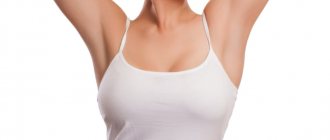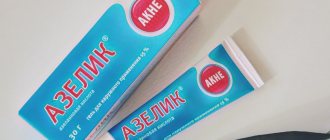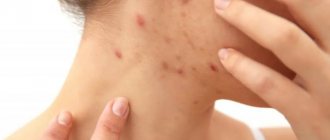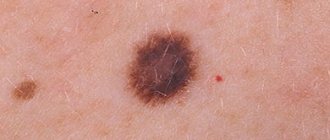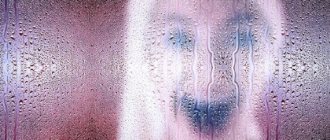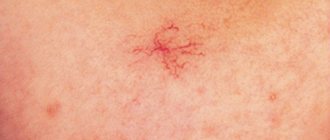Itching in the armpits is a fairly common phenomenon that almost every woman has encountered. But quite rarely people pay attention to this. But in vain, because a constant desire to scratch the skin of the armpits may indicate the presence of certain problems, and some of them are very serious.
The next time you feel itching in this area, do not be lazy to conduct a self-diagnosis. The problem may be much more serious than you think.
So, what could be hiding behind the itchy skin in the armpit?
Dermatitis
The skin in the armpit area is very delicate and reacts especially sharply to irritants. If your antiperspirant or deodorant contains too much alcohol, or your shower gel is too alkaline, contact dermatitis may occur. A similar reaction can be observed to some other irritants: synthetic underwear, silicone bra straps, metal blades on a razor.
Folk remedies
- birch decoction lotions;
- rubbing with chamomile tincture (a spoonful of dry raw materials is steamed with a glass of boiling water, infused, filtered, a couple of spoons of apple cider vinegar are added);
- rubbing with St. John's wort tincture (two tablespoons of plant material are poured with boiling water and infused);
- rubbing with a decoction of oak bark (pour a tablespoon of oak bark into a glass of boiling water and leave for two hours);
- rubbing with saline solution (two teaspoons of sea salt dissolved in a glass of hot water);
- wiping the affected areas with boiled sunflower oil;
- tobacco compresses (put a handful of tobacco on a bandage, moisten with a strong solution of potassium permanganate) are placed on the armpits at night.
Ingrown hairs
Women who prefer to use a razor instead of sugaring, waxing or laser hair removal often encounter this problem. Ingrown hair leads to inflammation, which can lead to infection and the development of a negative reaction.
There are several tips that can help reduce the likelihood of ingrown hairs as a result of shaving:
- the movement of the machine should be in the direction of hair growth;
- you should not frequently run the machine over the same area;
- Between shaving your armpits, you should leave intervals of at least 2-4 days to allow the skin to recover;
- To prevent ingrowth, it is recommended to peel the axillary area using delicate care products.
How to prevent armpit pain
- do not use antiperspirants and deodorants (what is the difference - we explained in this article) with aluminum and zinc, they clog pores, and also with triclosan - this is an antibacterial agent, entering the body through the pores, it can cause disruption of the functioning of the reproductive and endocrine systems;
- Shower regularly. Be careful when shaving so as not to injure sensitive skin;
- wear only clean clothes and wash T-shirts on time, especially in summer;
- Feel your armpits for any lumps or pain. This way you can detect the problem in time and contact a specialist;
- Do a warm-up before training. Start with low-amplitude swings of your arms, warm up your shoulders and elbow joints. It is especially important to warm up the shoulder girdle before doing pull-ups, climbing walls and other activities that involve stretching the muscles;
- be careful during sex. Some poses, such as doggy style with your arms extended forward, can lead to armpit pain. It's all about the slight stretch that the muscles undergo;
- Get regular checkups and monitor your health. This is easier and cheaper than treating an advanced disease later.
Psoriasis
The development of this disease is associated with instability of the emotional background, when, due to stress, depression, and nervous tension, the work of the sweat and sebaceous glands increases and they become clogged. As a result, the colony of pathogenic microorganisms increases in the pathological area, which leads to irritation and skin itching. It will not be possible to get rid of this problem with cosmetics alone; here you need medical help and the prescription of complex therapy, including taking medications.
Hormonal changes
All metabolic processes that occur in the human body are directly or indirectly controlled by hormones. The intensive restructuring of these processes, which occurs during puberty, pregnancy, or the onset of menopause, is accompanied by significant hormonal changes. A concomitant symptom may be itching in the armpits. Moreover, most often these unpleasant symptoms are caused by menopause.
Read also: Why do lips itch, dry, crack, peel: treatment
There are situations when the symptom in question is not a natural reaction of the body to the action of an external stimulus or to a change in some internal process, but a manifestation of pathology. The treatment and management tactics of the patient will depend on what caused the itching of the skin of the axillary fossa.
Lichen
The disease is fungal in nature and is characterized not only by itching, but also by severe redness of the skin, which has light flaky edges along the borders. Deprivation of lichen is possible due to indiscriminate contact, as well as due to non-compliance with personal hygiene rules. An effective measure against damage is the use of external antifungal agents.
As you can see, armpit itching is not always a harmless phenomenon. In most cases, it has its own reasons, and serious problems may be hidden behind it. So, carry out self-diagnosis in a timely manner, in case of any deviations, do not be lazy to consult a doctor, and along with home care, regularly visit a cosmetologist for professional caring procedures.
Photo source: Internet
Redness caused by fungi
Redness under the arms can be the result of a fungal skin infection called tinea capitis. Most often, this is candidiasis-dermatomycosis, caused by yeast of the genus Candida (most often Candida albicans). They are an integral part of a healthy body, but can cause problems if they multiply excessively. This occurs when the body’s immune defense is weakened (stress, exhaustion, antibiotics).
An important role in the development of these skin changes is played by local damage to which candida easily “attaches.” The fungus then manifests itself as an infection that affects the entire body (systemic infection) or specific parts of it, such as nails, skin, scalp or mucous membranes (vaginal candidiasis, candidiasis of the digestive system, skin infection - ringworm).
Most often, ringworm occurs in skin folds, under the arms, on the chest and in the groin. It begins with mild itching, followed by redness, cracking, and marginal peeling of the skin. It is treated with antifungal creams under the supervision of a dermatologist.
To prevent the development of dermatomycosis, it is necessary to keep the areas of skin folds clean and dry, since moisture promotes the growth of fungi. Fungal infections are also more common in areas where there are large numbers of people, such as schools, daycare centers and swimming pools. Therefore, after visiting public areas, it is recommended to take a shower and dry thoroughly with a towel so that moisture does not get into the armpits and other folds of the skin.
Traditional Treatments
The appearance of a rash in an adult is an alarming sign. There is no point in waiting for its further spread. It is better to get diagnosed and start treatment as early as possible. In some cases, this will protect not only the victim, but also his loved ones.
Treatment for the rash depends on the disease that caused it:
Allergic formations are treated with antihistamines for internal use (Suprastin, Zodak, Zirtek) and special creams and ointments to relieve itching, swelling, and aid in tissue regeneration (Fenistil, Epidel, zinc ointment, etc.). Diseases of a non-allergic nature are treated with traditional medicine (chamomile, mumiyo, salicylic acid, etc.), as well as medications based on zinc, azelaic acid retinoids, etc.
It is very important to maintain diet and fluid balance during therapy. Infectious rashes caused by “childhood” diseases cannot be treated with special means
All symptoms go away on their own after the required time. You can only make this period easier for the patient with the help of nasal medications and antipyretics (for scarlet fever, antibiotics can be prescribed). Scabies, herpes and syphilis require medical treatment, drugs for which are prescribed by a doctor.
» alt=»»>
To eliminate the problem, you first need to investigate the cause of the occurrence. If it is associated with the use of specific cosmetics, they must be eliminated and replaced with better ones that are suitable for sensitive skin. The first step to recovery is to practice daily hygiene.
You need to wash your armpits with products that do not cause allergic reactions and are suitable for a certain skin type. If the skin sweats more during the summer, a saline solution (2 spoons per 1 liter of water) is suitable for washing.
To treat severe irritation under the arms:
- Petrolatum;
- Ointments containing cortisone (Dermatop, Fluvet, Ultralan);
- Preparations based on zinc oxide (Zinc ointment, Desitin, Diaderm, Tsindol).
Very frequent application of oily products to the affected areas with hair can cause clogging of the follicles, and this will further aggravate the situation. In mild cases of fungal skin lesions, the use of local agents is sufficient: Lamisil, Mycoseptin, Lamikon, Clotrimazole.
In more severe forms, oral antifungal antibiotics are required: Amphotericin B; Nystatin; Levorin. For complex forms of dermatitis, combined hormonal ointments are used: Lorinden; Sinalar; Akriderm; Sinaflan; Pimafukort.
In addition to corticosteroids, they may contain antifungal and antibacterial components. If the irritation is caused by fungi or bacteria, it should be treated under the supervision of a dermatologist. Sedatives: Novo-Passit; Phytosed; Sedavit; Valerian tincture. Antihistamines: Zodak; Suprastin; Cetrin; Claritin.
Therefore, local remedies will be ineffective. If a blood test confirms high sugar levels, you must be examined by an endocrinologist so that he can prescribe appropriate treatment. For irritation in the armpits, a low-carbohydrate diet and taking a complex of multivitamins and immunostimulants are recommended.
Preventive and therapeutic measures for adults
Regular check-ups with your local pediatrician are an important part of your preventative measures. If alarming symptoms cannot be avoided, use baths of decoctions of sage, mint, chamomile, sprinkled with powder. If you are unsure about the origin of the rash, seek medical attention immediately.
- Most of the above diseases can be easily prevented with regular hygiene procedures and the selection of appropriately sized clothing made from natural materials. If you have symptoms:
- It is not recommended to scratch itchy areas;
- use vinegar solutions or lemon juice to relieve discomfort;
- You should temporarily avoid cosmetics and hair removal;
Replace clothing with looser cotton ones.
Preventing itching
It is easier to prevent severe irritation than to carry out full-fledged therapy later. Following simple rules can protect the skin from unpleasant consequences, such as pain, redness, burning, etc. Recommendations for the prevention of unpleasant symptoms and other skin problems:
- Clean your armpits a couple of times a day.
- To remove hair, use only a sharp razor, moisturizing the skin in advance.
- Apply antiperspirant half an hour after showering.
- It is better to trim long hair in the armpit area with scissors before shaving.
- It is better to choose clothes from natural fabrics and make sure that they do not fit tightly to the skin.
Self-medication takes place after the approval of the attending dermatologist. When using drug therapy, it is important to complete it so that the viruses do not develop resistance to the drugs. This will also eliminate the occurrence of relapses. Symptoms of irritation can be relieved in the absence of a provoking illness using both folk remedies and proper adherence to preventive measures and personal hygiene standards.
Complications
Diaper rash under the breasts brings a lot of discomfort. This pathological condition requires mandatory treatment, as skin infiltration may develop. The itching becomes more intense, and scratching provokes the formation of wounds. Dermatitis is complicated by the development of pyoderma or candidiasis. Promotes the development of pathological processes:
- insufficient amounts of vitamins entering the body cavities;
- decreased body resistance;
- disturbance of carbohydrate metabolism;
- diseases of the gastrointestinal tract in a chronic form;
- autoimmune diseases.
Symptoms of the disease
The rash and the resulting itching, as a manifestation of an internal disease, require much more attention. Here it is impossible to do without contacting a medical institution for professional help, which will allow you to establish the cause and determine effective treatment. Some of these diseases affect both adults and children, while others may only occur in certain age groups. When it comes to groin infections, the most commonly mentioned are:
- Scabies,
- hidradenitis,
- psoriasis,
- Candidiasis
- furunculous.
Scabies itching
An infectious infection transmitted by direct contact with its carrier. A favorable background for the spread of the parasite is crowded conditions. The irritating factor is the channels pierced by mites in the skin and the deposits of waste products in them. In primary infections, the first symptoms appear four weeks after infection. Risk areas include sensitive areas of skin between the fingers, lower abdomen and armpits. The first symptom is the accompanying rash.
- the appearance of severe itching, especially felt at night;
- The appearance of linear scabies with characteristic black dots at the entrance to the sewer and at the exit of the mites;
- redness of the rash;
- Skin erosion, the formation of pustular vesicles that open and contract when scratched.
Proper treatment under the supervision of a dermatologist will quickly get rid of the disease by eliminating the pathogen itself.
"Bitch udder" or hidradenitis
Inflammation of the sweat glands due to staphylococcal infection. The risk of disease increases if hygiene rules are not followed or the immune system is weakened due to certain diseases:
- skin abnormalities;
- presence of diaper rash;
- neglecting the shower;
- improper hair removal;
- problems with the endocrine system;
- dysfunction of the sweat glands;
- obesity.
In adults, the location depends on gender, with men more often affected in the groin, and women more often in the groin. The main symptom is a clearly defined thickening that takes on a purplish-red color. The disease is accompanied by:
- itching around the lesion;
- General unhappiness;
- Heat.
After a few days, the nodule grows up to two centimeters, after which it infiltrates and is pushed out. It will alleviate the condition, but it will not eliminate the disease itself, since there is an increased risk of developing new glands.
Squamosal lichen
Commonly called psoriasis, it affects people of all ages. The occurrence of anomalies associated with abnormalities of the skin, the provoking factor may be elementary weakness, weakening of the immune system due to diseases. Revealed:
- flat thickening of the skin, rising above healthy areas of the skin;
- change in color of the affected fragments to pale, gray or silver;
- the formation of hard plaques covering large areas of the skin;
peeling and itching.
Fungal infection
The treatment method is selected individually by the dermatologist, depending on the general condition of the patient and drug tolerance.
- A fungal infection caused by the yeast Candida. The source of infection can be dirty vegetables and fruits, household items, and soil. Factors contributing to this phenomenon:
- stressful situations;
- Hypothermia;
- hormonal problems;
- sexually transmitted infections;
- various infections;
- thyroid diseases;
- Diabetes;
tight and synthetic clothing.
Boil or furunculosis
It may be erythematous or vesicular. In the first case, wet erosions form on the skin, and in the second - blisters, pustules or nodules. Accompanied by burning and peeling of the affected areas. If this happens, do not rely on the "pass on" principle; a complication in the form of a drug-resistant strain may occur, making full recovery difficult.
- A bacterial infection that affects hair follicles, sebaceous glands and surrounding tissues. Preferred backgrounds:
- microtraumas, contamination;
- increased sweating;
- poor nutrition;
- impaired metabolism;
decreased immunity.
